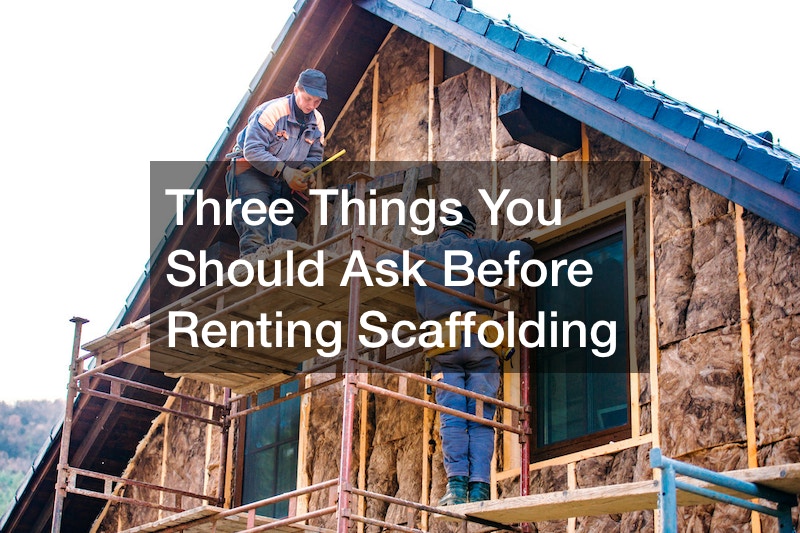
Temporary scaffolding platforms can make a difference in a building project. Moreover, a scaffold platform improves efficiency and promotes safety and comfort. Avoid using uncomfortable ladders to reach crucial spots, and use a reliable scaffold to save your tools and have everything you need nearby. If you have trouble with your building project, hire local scaffolding solutions and improve your workflow.
As you might expect, there are countless types of scaffolds. However, there’s one that might be perfect for your project. A one man scaffolding platform is great for those tight spaces that need only one worker. However, if your building project is massive and requires the attention of numerous workers simultaneously, you might need a stairwell scaffold. Each scaffold steps requires concentration and knowing what you are doing. Only hire professionals who understand how to deal with scaffolding platforms and are comfortable working on top of them. Lastly, find reliable providers who give you quality scaffolding platforms that hold your workers’ weight.
Scaffolding platforms are an iconic element of every construction site. Moreover, they are must-have tools that will help you with your project.

Are you interested in scaffolding rentals? When you have a project that has to be conducted at a height, trying to get it done from a ladder is unsafe and inefficient. Climbing up and down the ladder to get supplies and to re-position it wastes valuable time and drains your energy quickly.
Instead, using scaffolding rentals gives you a stable and safe platform so that you can get the job done quickly and — most importantly — safely.
Of course, scaffolding rentals are only safe and functional when they are installed and used properly. When you get your scaffolding rentals, make sure you take the time to learn proper usage.
Three Things You Should Ask Before Renting Scaffolding for the First Time
- What are the basic components of the scaffolding I’ll be using today?
An important factor in ensuring that your scaffolding is safe and secure is understanding what components are involved in the scaffolding, and how they work together. This way, you’ll know if your scaffolding is not set up properly, and will be able to make adjustments before climbing up it.
The scaffolding that are offered to the public by most equipment rental companies is called “pipe scaffold” and is ideal for exterior work on a standard sized home or business (unless you’re needing to make repairs to the fifteenth floor of your skyscraper; if so, you are reading the wrong article). Pipe scaffolding is made up of these components:- Guardrail system to prevent you from falling off of the scaffolding.
- Base plates to provide stability to the foundation of the scaffolding.
- End frames that are five feet long, which supports the platform of the scaffolding.
- Cross braces are installed to provide extra rigidity and support to the system.
The scaffolding is generally five feet wide and tall, and can be stacked next to or on top of each other to provide a larger or taller working area. Your equipment rentals specialist will likely suggest limiting the height to two section, as any taller than that can create issues with stability. If the height has to exceed three times the width of the tower, it needs to be attached to the structures you are working on. Tie-ins are something that you should talk to your specialist about if you are needing that much height.
- How do the base parts go together?
Your base pieces are essential for the stability of your scaffolding. You need to be thoroughly versed in how to assemble it properly. In order to assemble you scaffolding:- Attach the screws and base casters to the pipes before you put anything together. You’ll probably have to adjust this later, but if you don’t put them on in the beginning, you’ll have to lift the entire structure to put them in later.
- Each scaffolding manufacturer’s hardware is slightly different. You should read the instructions for properly tightening the base of your structure.
- It is important that the base of the scaffolding is set up on solid and stable ground. If your scaffolding is going on dirt or grass, you should install the base over pieces of lumber. If the ground slopes by more than a foot per eight feet, you should install leg extensions. Never use a substitute for leg extensions (like bricks or blocks). The base of your scaffolding is key for the entire structure. This is a very important step.
- Now that the stage is set, you can adjust the screws that you previously slid onto the pipes and get your scaffolding up!
- How should the rest of the scaffolding be erected?
As we mentioned, each scaffolding manufacturer has their own system for erecting their product; you should ask for the manufacturer’s directions before installing yours. However, here is a basic overview:- Raise the planks that come with your rented scaffolding so that they are above your frame, and then lower it to hook into the frame.
- You might be tempted to just use your own wood planks instead of renting ones from the equipment rental store. However, these are not designed for the weight you’ll be putting on it, and are unsafe.
- Install rails on each side of the scaffolding, other than the side that is facing the building.
- Install toe boards with 2x4s to ensure tools or supplies don’t fall on people below.
Do you have questions? Share below!

